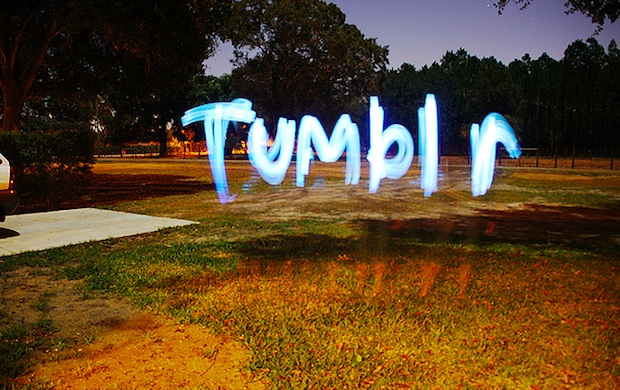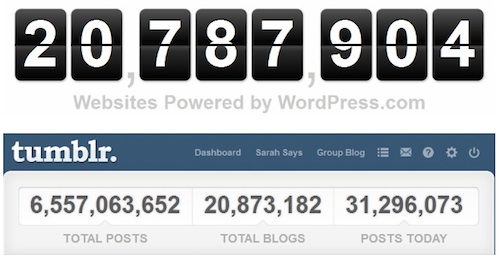
According to numbers dug up by Mashable, microblogging newcomer Tumblr has just surpassed the 20.7 million blogs hosted by WordPress--explosive growth since it only hosted around 7 million blogs as recently as January. Exponential growth like this means it's probably just the beginning of many record-breaking events.
WordPress, like peer Drupal, has the air of a "professional" blog-hosting site, compared with other offerings like Blogger, because it has extensive controls and complexity, it takes a little getting used to, and is used by a wide range of professional companies to host their sites. Tumblr is much simpler, with more limited range for customization and complexity, and only recently included the ability to add comments. With its emphasis on short, pithy posts, and habitual use as a photo-publishing and social-sharing site, Tumblr posts are more closely related to Twitter feeds than professional, hefty, WordPress sites.

Tumblr's simple code, which includes free built-in templates that instantly transform even a beginner's Tumblog into a very visually attractive affair, presents a very low barrier to entry. And it's easy to update it and add new content (you can even email stuff in, and the rest happens automatically). This makes it attractive to Net coding novices. The fact that a social-sharing angle is built in makes sharing feel intuitive, rather than a bolted-on "share on Twitter"-type interaction you'll typically find on bigger publications (including FastCompany.com). But more and more big-name companies are hosting additional sites on Tumblr. Low-tech simplicity, skyrocketing membership numbers, and Tumblr's dominant social angle help companies and publications spread their messages further, more quickly, than they can in the typical battle for pageviews on a more traditional platform.
Speaking at the Fashion Institute of Technology earlier this year, Tumblr founder David Karp mentioned this relaxed, congenial style of blogging, noting that Tumblr censors "hate words" from comments. "It's hard to hurt someone with a heart button," Karp said. He also drew comparisons to MySpace, "before they let it all go to sh*t," saying Tumblr really is intended as a place for creativity and sharing. Answering a Quora question on the matter, Dan Goodswin, who runs the popular Total Film blog, similarly notes "Tumblr culture is heavily meme based, with fashion, photography and pop culture all heavily viral across the network."
Like Tumblr, Twitter is also about pithy content sharing. But it retains a very text-based model, even with moves to centralize its picture-sharing powers. Goodwin also sums this up, "An image post on Tumblr is almost always more viral than a short text post, and pictures/GIFs are generally more popular than video/audio/link posts." And Tumblr users are much more engaged than Twitter users, with a very high percentage of dormant Twitter usernames versus a much greater active membership on Tumblr.
Tumblr's meteoric rise proves there's a desire for simple, elegant, short-form-content blogs that are heavy on imagery--a model that is being echoed elsewhere in the rise in photo sharing through iPhone apps like Instagram or Color.
If Tumblr does continue to expand, and Twitter is to compete (albeit with a slightly different content-sharing model) it may find itself having to make an even better system to share and embed images and video in tweets. And more traditional blogs are already waking up to the need to share content on social networking forums as a way to both promote their content and engage in conversations with users--and it's possible we'll see more and more brands embracing Tumblr as a channel for simple message communication.
[Image: Flickr user jessaax]
Chat about this news with Kit Eaton on Twitter and Fast Company too.
Kristin Cavallari Brittany Murphy Britney Spears Amanda Swisten Scarlett Chorvat
No comments:
Post a Comment